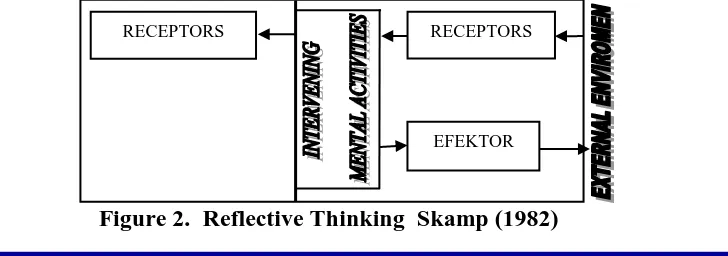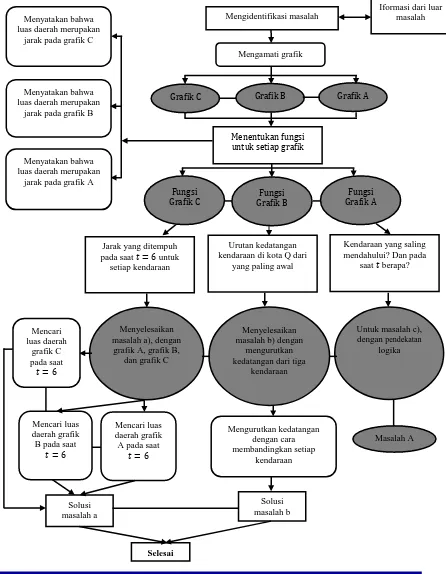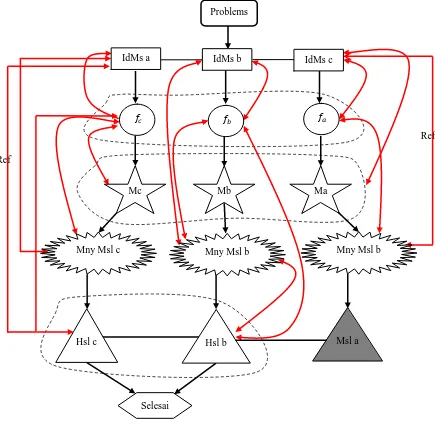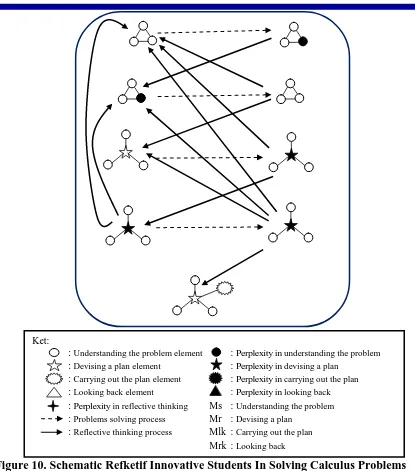E
–
31
The Innovative Reflective Thinking Process In Solving Calculus
Problems
1 In Abdullah, 2Hery Suharna
1,2
Study Program of Mathematics Education 1,2
Faculty of Teacher Training and Education. Khairun University of Ternate 1
Email: [email protected]. 2Email: [email protected].
Abstract
The process produces a mental representation that is a representation of thinking through the information transformation involves a complex interaction. The thought process that helps integrate reflective ability of a person is thinking. Reflective thinking is very important for students and faculty. But this is very different from the facts on the ground, as in mathematics professors still see the student's work without seeing how the student to find the results. Reflective thinking is occurring at each student as an individual, especially prospective teachers in teaching practice. Reflective thinking is needed by faculty and students to deal with the complexity of learning. The things that are important to note: (1) reflective thinking required by lecturers and students to deal with the complexity of learning, (2) to enhance learning, especially how the thinking, teaching, and learning; and (3) lecturers to adjust the mathematical material given to the student's developmental level mathematics scheme, customize the presentation of the material with a reflective thinking process of students, as well as gradually, the need to increase student independence in learning. Reflective thinking is one of the innovative thinking found that the flow obtained from the research. Innovative reflective thinking process is going on at the time have problems, confusion or doubt on the troubleshooting steps, the next obstacle is overcome by linking the information needed and then draw conclusions to develop a new concept and apply it and adding information from the given problem. Another feature that is obtained in the process of reflective thinking in innovative ways to solve it with the unusual, unique and different.
Keywords: Reflective thinking, Innovative, and Problems in Calculus
A. Introduction
Calculus problem-solving skills, an ability essential in reflective thinking, which is recommended to be raised reflective thinking since elementary school age students to the level of (see [3]). Every student of any level math skills and formal education need to be trained in problem solving capability calculus.
The process of thinking is the process of generating a mental representation that is a representation of thinking through the transformation of information that involve complex interactions. The thought process that helps integrate the reflective ability of a person is thinking. Reflective thinking is very important for students and faculty. Reflective thinking is a process that reconstructed the knowledge of students. Therefore, reflective thinking is important in understanding the mathematics, especially calculus.
The description above is very different from the facts on the ground, as in mathematics professors still see the student's work without seeing how the student to find results. Reflective thinking is happening at each student as an individual, especially prospective teachers in teaching practice. Reflective thinking required by lecturers and students to deal with the complexity of learning. Important things to note:
International Seminar on Innovation in Mathematics and Mathematics Education
given developmental level math students scheme, adjust the process of presenting the material with a reflective thinking process of students, as well as gradually, need to increase student independence in learning.
Based on the above background in this study raised the question of "how the reflective process of innovative thinking in solving calculus problems". While an advanced student research subjects are students who have passed the course calculus I and calculus 2 Reflective Thinking innovative thinking is one of the grooves found that the results obtained from the study, using instruments calculus.
B. The Proses of Reflective Thinking
Information processing in the human mind [5] which can be described as shown in Figure 1 below:
Figure 1. Information Processing
Thinking is defined as sutu process involving some manipulation of knowledge in the cognitive system as described above, in which all processes that lead to a conclusion or directed to produce a resolution. Here's notion of thinking refletif. Dewey [1] states that reflective thinking is:
“ …. reflective thinking is active, persistent, and carefull consideration of any belive or suppose from of knowledge in the light of the grounds that support it and the conclusion to which it tends…”
Thus reflective thinking is constantly active, persistent, and careful consideration of everything unbelievable truth. Furthermore, Dewey [1] revealed that there are three important parts in reflective thinking, namely: (1) Curiosity (curiosity) is a curiosity about the explanation of phenomena that require answers are obvious facts and his own desire to seek answers to the problems in the lift, (2) Suggestion of ideas is designed by students as a result of his experience. Advice should be diverse (so that students have a lot of choice and wide) and deep (to understand the core of the problem), (3) Orderliness is the ability to summarize his ideas to form a harmonious unity towards a conclusion. Furthermore, the process of reflective thinking [4] as follows:
Figure 2 The process of reflective thinking is the ability to respond to external information that is forwarded to the mental activity (internal information) in response to the problems with the idea of communicating with symbols or pictures. Furthermore, responding to an issue as the effect of external reflective thinking. Information processing is the process of reflective thinking.
The situation Dewey [1] suggested that reflective thinking is when a person experiences confusion (perplexity) and conduct an investigation to find the solution to the problem (inquiry). Confusion (perplexity) is the uncertainty and difficulty in understanding something and then challenge the mind to make changes. Inquiry is looking for information that directs the activities of the mind to the resolution of the problem. By allowing confusion and investigations occur at the same time, changes in a person's behavior can be seen, such a habit of reflective thinking menjdi allowing no change someone's behavior in solving the problem. The process according to Dewey's reflective thinking can be seen in the following figure:
Figure 3. Occurrence of reflective thinking processes (Dewey [4])
Based on what was presented by Skemp and Dewey on top, then the process of reflective thinking that is the occurrence of confusion (perplexity) or the clash of ideas. Further confusion (perplexity) or collision is resolved to arrive at a solution for problems.
C. METHODS
This study aims to explore the process of reflective thinking of students with logical approach in solving the problems of speed, distance, and time. Therefore, research is descriptive qualitative approach. Step-by-step analysis of the data in the study: (1) to process and prepare the data; (2) read through the data; and (3) to analyze in more detail by clicking on the coding of data. The data in the analysis is the observation the researcher as instrument, the student's work (TMMM) and interviews on the subject of research.
D. The Innovative Reflective Thinking Process in Solving Calculus Problems
In completing TMMM, when the subject is not sure to understand the problem with the given problem. Here are excerpts of interviews investigators and subjects: (PS-1) "What did the first time? " (S-(PS-1) "emmmm,,, seek distance, v multiplied by hours subject, which is based on previous experience in high school. Uncertainty is described by the subject when asked "do not you pack" but the subject convince yourself by repeatedly. This is evident from the statement that the subject (S-15) "that (a) the first Pak" as well as the statement (S-17) "so looking at that area of the curve c 'and (S-18) "
60 times 6 ( )”. That b (ie graphs b) the distance that this (pointing the chart on Perplexit
Inquiry
International Seminar on Innovation in Mathematics and Mathematics Education
the subject matter and a drawing). And that is a (mean graphs a) it's every one hour increase in the 10, the 40 hour rise, continue to 90, continues to 160, and so on.
The process of reflection that occurs is doing every question with re-understand the problem, the process is done repeatedly, for example: in answering the question of how the distance of each vehicle at the time? By way of adding speed every hour until the 6th hour the graphs is known.
Figure 4 .Answering Questions (a)
Similarly, when work on the problems (b), the reflection process in solving the problem by going back to a given problem or known. This reflection process is done continuously memerus.
Figure 5. Answering Questions (b)
Figure 6. Answering Questions (c)
The process of reflection that is done is to go back to the links between the concept of the material speed, distance and time that is given to the problem with the logic of the approach as follows:
Figure 7. Reflective Process When Answering Questions (a)
International Seminar on Innovation in Mathematics and Mathematics Education
Figure 8: The Structure of Student Thinking in Solving Calculus Problems
Based on the above results, it is in solving calculus problems occur reflective thinking processes occur at each step problem solving calculus. Collision occurs during the process of reflection to understand the problem premises recollect what has been obtained in previous education. Similarly in steps to plan, implement and check back.
Furthermore, the structure can be presented reflective thinking in solving calculus problems for subject 1: Structure of reflective thinking of students in solving calculus problems can be presented in the form of the following scheme:
Figure 9: The occurrence of reflective thinking process in solving calculus problems
The process of reflective thinking in solving calculus problems performed by the subject, can be presented in the following scheme:
Ref
Ref
Hsl c Hsl b
Mny Msl c Mny Msl b Mny Msl b
Mb
Mc Ma
IdMs a IdMs b IdMs c
Problems
Selesai
Figure 10. Schematic Refketif Innovative Students In Solving Calculus Problems
The above description shows that the innovative process of reflective thinking in solving calculus problems. Innovative reflective thought process occurs in steps to understand the problem, devise a plan and implement the settlement plan.
E. Discussion
Innovative reflective thinking process is going on at the time have problems, confusion or doubt in step problem solving calculus, then these obstacles be overcome by linking the information needed to build and then draw conclusions and apply a new concept and add information from a given problem. Another feature that diproleh in the process of reflective thinking in innovative ways to finish with an unusual, unique and different.
F. References
[1] Dewey J. 1933. How We Think: A Restatement of the Relation of Reflective Thinking to the Educative Process, Boston, MA: D.C., Heath and Company.
Ket:
: Understanding the problem element : Perplexity inunderstanding the problem : Devising a plan element : Perplexity indevising a plan
: Carrying out the planelement : Perplexity incarrying out the plan : Looking back element : Perplexity inlooking back : Perplexity in reflective thinking Ms : Understanding the problem : Problems solving process Mr : Devising a plan
International Seminar on Innovation in Mathematics and Mathematics Education
[2] Gurol. A. 2011. Determining the reflective thinking skills of pre-service teachers in learning and teaching process. Energy Education Science and Technology Part B: Social and Educational Studies 2011 Volume (issue) 3(3): 387-402.
[3] NCTM. 2000. Principle and Standards for School Mathematics. Reston: The National Council of Teacher Mathematics, Inc.
[4] Skemp, R. 1982. The Psychology of Learning Mathematics. USA. Peguin Books. [5] Slavin, R. 2006. Educational Psychology Theory and Practice. Eighth Edition. New
York. Pearson.
[6] Suharna. Hery. 2012. Reflective Thinking In Problem Solving Student Looking Back On Stage. Makalah disajikan dalam seminar Internasional Confrerence On Applied Mathematices and Education UIN Yogyakarta.

![Figure 3. Occurrence of reflective thinking processes (Dewey [4]) reflective thinking that is the occurrence of confusion (perplexity) or the clash of ideas](https://thumb-ap.123doks.com/thumbv2/123dok/1072643.872811/3.595.123.449.253.384/occurrence-reflective-thinking-processes-reflective-occurrence-confusion-perplexity.webp)



